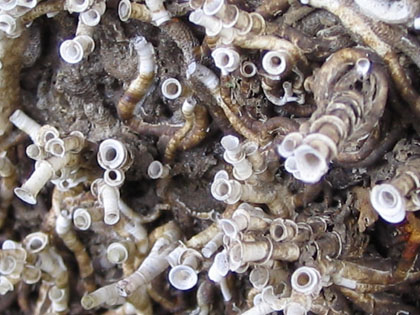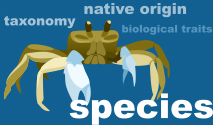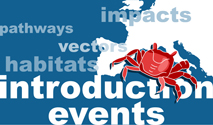 |
AquaNISInformation system on aquatic non-indigenous and cryptogenic species |
-

Copyright: Dan Minchin. Anguillicoloides crassus.
-

Copyright: Sergej Olenin. Codium fragile fragile.
-

Copyright: Dan Minchin. Crepidula fornicata.
-

Copyright: Damien Offer. Didemnum vexillum fouling.
-

Copyright: Dan Minchin. Ficopomatus enigmaticus.
-

Copyright: Dan Minchin. Hemimysis anomala swarm.
-

Copyright: Dan Minchin. Sargassum muticum fragment.
About AquaNIS
AquaNIS is an online information system on the aquatic Non-Indigenous Species (NIS), and species which might be considered as NIS, i.e. cryptogenic species. The system stores and disseminates information on NIS introduction histories, recipient regions, taxonomy, biological traits, impacts, and other relevant documented data. Currently, the system contains data on NIS introduced to marine, brackish and coastal freshwater of Europe and neighboring regions, but may be extended to other parts of the World.
AquaNIS seeks to ensure the long-term maintenance and reliability of the database by continuous update and scientific validation of its data, making it useful for research and practical for management. We believe that the content will be of value in relation to the management of the EU Water Framework Directive, The Marine Strategy Framework Directive, Risk Assessment measures for different pathways, especially shipping and aquaculture.
AquaNIS is a living database and is constantly updated with new records. All entered data is checked as far as is possible to current taxonomic status and references are supplied to qualify each of the datasets. All of the submitted data is to the best of our knowledge accurate. However, we do not accept any legal responsibility as to how the information derived from this database is interpreted or used.
The database will be gradually opened for free access in modules according to each state of completion. See "Regions available for public access" below.
- Pseudopolydora kempi japonica in France / Biscay Gulf [2025-01-24]
- Isognomon legumen in Italy / Central Mediterranean [2025-01-15]
- Palaemon longirostris in Poland [2024-12-31]
- Hemigrapsus takanoi in Poland [2024-12-31]
- Bursatella leachii in France / Western Mediterranean [2024-10-28]
- Neomysis americana in France / Biscay Gulf [2024-10-28]
- Crepipatella dilatata in Spain / Iberian Coastal [2024-10-28]
- Crepipatella dilatata in Portugal / Iberian Coastal [2024-10-28]
- Hepatospora eriocheir in Poland [2024-08-25]
- Tylosurus crocodilus in Italy / Adriatic Sea [2024-06-05]
- AquaNIS. Editorial Board, 2015. Information system on Aquatic Non-Indigenous and Cryptogenic Species. World Wide Web electronic publication. www.corpi.ku.lt/databases/aquanis. Version 2.36+. Accessed 2025-01-31.
- Data provider(s), 2015. Species name. In: AquaNIS. Editorial Board, 2015. Information system on Aquatic Non-Indigenous and Cryptogenic Species. World Wide Web electronic publication. www.corpi.ku.lt/databases/aquanis. www.corpi.ku.lt/databases/aquanis. Version 2.36+. Accessed 2025-01-31.
- Data provider(s), 2015. Species name introduction to [Here goes the name of Recipient Region]. In: AquaNIS. Editorial Board, 2015. Information system on Aquatic Non-Indigenous and Cryptogenic Species. World Wide Web electronic publication. www.corpi.ku.lt/databases/aquanis. www.corpi.ku.lt/databases/aquanis. Version 2.36+. Accessed 2025-01-31.
- Gollasch S., 2015. Sargassum muticum. In: AquaNIS. Editorial Board, 2015. Information system on Aquatic Non-Indigenous and Cryptogenic Species. World Wide Web electronic publication. www.corpi.ku.lt/databases/aquanis. www.corpi.ku.lt/databases/aquanis. Version 2.36+. Accessed 2025-01-31.
- Minchin D., Cook E. J., 2015. Mercenaria mercenaria introduction to United Kingdom (Britain). In: AquaNIS. Editorial Board, 2015. Information system on Aquatic Non-Indigenous and Cryptogenic Species. World Wide Web electronic publication. www.corpi.ku.lt/databases/aquanis. www.corpi.ku.lt/databases/aquanis. Version 2.36+. Accessed 2025-01-31.
- Strubbe, D., White, R., Edelaar, P., Rahbek, C., & Shwartz, A. (2019). Advancing impact assessments of non-native species: strategies for strengthening the evidence-base. NeoBiota, (51), 41-64. View online
- Casties, I., & Briski, E. (2019). Life history traits of aquatic non-indigenous species: freshwater vs. marine habitats. Aquatic Invasions, 14(4), 566-581. View online
- Duarte, S., Vieira, P. E., & Costa, F. O. (2020). Assessment of species gaps in DNA barcode libraries of non-indigenous species (NIS) occurring in European coastal regions. Metabarcoding and Metagenomics, 4, e55162. View online
- Shalovenkov, N. N. (2020). Tendencies of Invasion of Alien Zoobenthic Species into the Black Sea. Russian Journal of Biological Invasions, 11(2), 164-171. View online
- Bojko, J., Burgess, A. L., Baker, A. G., & Orr, C. H. (2020). Invasive non-native crustacean symbionts: diversity and impact. Journal of Invertebrate Pathology, 107482. View online
- Obst, M., Exter, K., Allcock, A. L., Arvanitidis, C., Axberg, A., Bustamante, M., ... & Pavloudi, C. (2020). A marine biodiversity observation network for genetic monitoring of hard-bottom communities (ARMS-MBON). Frontiers in Marine Science, 7. View online
- Tsiamis, K., Azzurro, E., Bariche, M., Çinar, M. E., Crocetta, F., De Clerck, O., ... & Cardoso, A. C. (2020). Prioritizing marine invasive alien species in the European Union through horizon scanning. Aquatic Conservation: Marine and Freshwater Ecosystems, 30(4), 794-845. View online
- Joana, A., Antunes, J. T., Machado, A. M., Vitor, V., Leão, P. N., & Elsa, F. (2020). Monitoring of biofouling communities in a Portuguese port using a combined morphological and metabarcoding approach. Scientific Reports (Nature Publisher Group), 10(1). View online





